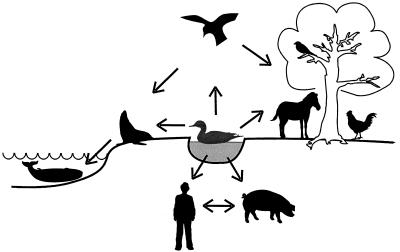FIG. 1.
“Habitat” of influenza A viruses. Ecological and phylogenetic studies suggest that wild waterfowl are the principal reservoirs for influenza A viruses, which occasionally are transmitted to other host animals such as horses, pigs, and chickens, leading to influenza outbreaks among these species. Some of the viruses may become established in these new hosts and cause epidemics and epizootics. Viruses are transmitted among these new host animals (e.g., between humans and pigs or between chickens and humans, as occurred in 1997 in Hong Kong).

